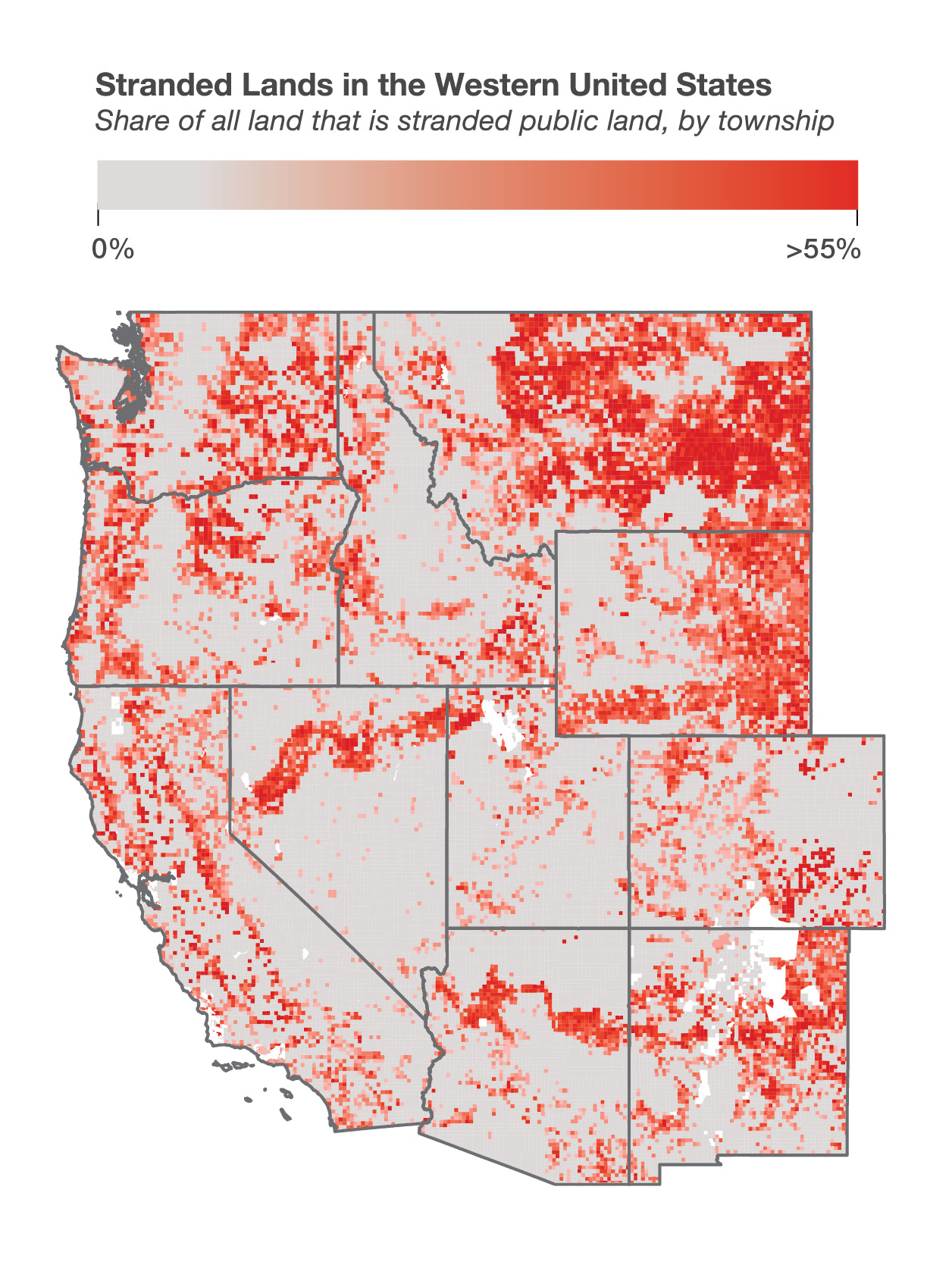Spend enough time roaming the American West and you’ll likely encounter it: a parcel of land that’s labeled as public on a map but is entirely landlocked by private lands. Access to these “stranded lands” is often prohibited without permission from a neighboring landowner, creating obstacles for recreationists and land managers alike. As pressure builds to improve public land management, and enhance access to those lands, debates over stranded lands have been intensifying.
Bryan Leonard, a PERC senior research fellow and economist at Arizona State University, began studying these lands after hiking throughout the West and discussing management challenges with ranchers in Montana. He is the author, along with Andrew Plantinga of U.C. Santa Barbara, of several recent studies examining the effects of stranded lands on local economies, recreational access, and resource management. We asked Leonard about his research and what it means for the West.
Q: First off, how much stranded land is there in the West?
A: We estimate there are about 6 million acres of inaccessible public land in 11 western states. Most of that land is managed by the Bureau of Land Management (55 percent) and by states as trust lands granted at statehood (40 percent), with the other federal agencies making up the remainder (5 percent). These stranded lands are concentrated in sparsely populated areas such as Eastern Montana, Eastern Wyoming, Northern Nevada, and Northern Arizona. Montana has the most, with 1.9 million inaccessible acres.
Q: Why is there so much stranded land?
A: Unlike national parks and many national forests that were intentionally set aside for specific purposes, most stranded lands are accidents of history associated with land-disposal policies in the 19th century. The entire West is organized into six-mile by six-mile “townships” in the federal government’s Public Land Survey System, with each township containing 36 sections numbered from 1 to 36. The government often gave away land based on section numbering to avoid favoritism, but the practice resulted in a fragmented mosaic of public and private land. For example, states were typically granted sections 16 and 36 in every township, and settlers could claim title to parcels ranging from a quarter section (160 acres) to a full section (640 acres) under the homestead acts.
Railroad land grants of the 19th century were a major factor as well. To encourage the construction of the transcontinental railroads, the government granted railroad companies every odd-numbered section within 20 to 40 miles of track as it was completed. Many of the even-numbered sections were never disposed of and remain in federal ownership. This created a checkerboard of private and public land that still exists in certain places, especially Wyoming, Eastern Montana, and Northern Nevada.
The result is that public land is scattered amidst private lands across much of the West. Unless these stranded public lands intersect a public road, they are generally inaccessible to the public. And because it’s not possible to “corner cross” from one public parcel to another without illegally trespassing on private lands, access to “checkerboarded” lands is often prohibited.
Q: Why does strandedness matter? What are the economic implications?
A: In general, the effects of stranded lands on local economies may be different than the effects of other public lands, because stranded lands usually cannot be used by the public for recreation. The impact on other land uses likely depends on a variety of factors. A stranded tract of public land encompassed by a large ranch may essentially be treated as if it’s part of the rancher’s property. On the other hand, more intensive uses such as timber harvesting or mineral development may be precluded on stranded lands if developers cannot obtain legal access to them.
In our research, we find that having more stranded land in a county reduces land values. We also find that the net effect of stranded land is significantly more negative than it is for accessible public land, suggesting that the inability to access land for recreation may be especially important.
Q: What does this mean for access—both for management and recreation?
A: Generally, stranded land cannot be accessed by the public for recreation or by government agencies for management activities. Recreationists usually aren’t missing out on opportunities for long hikes because these parcels tend to be relatively small, but other activities like hunting and climbing can be affected because stranded land can harbor wildlife or even mountain summits. On the management side, activities like forest thinning and invasive species control are also imparied by public agencies’ inability to access stranded land.
Q: What about wildfires?
A: In more recent work, we’ve found that fires that start on stranded lands are more likely to escape containment and grow larger than fires that start on comparable, nearby accessible land. There’s some evidence to suggest that this is driven in part by a lack of fuel management activities on stranded lands, which are precluded by agencies’ inability to access the land. Once a fire starts, landowners are unlikely to bar access for firefighters, but the added hurdle of coordinating with landowners to secure access may also delay response times, creating larger fires.
Q: What can be done to address the problem of stranded lands?
A: The upshot of our research is that even marginal changes in land ownership patterns that improve public access while strengthening private property rights can result in large economic benefits. One way to do this is through “land swaps,” where the government consolidates its landholdings by exchanging some of its land for nearby private land, especially in checkerboards. Well-executed land swaps can be a win-win that creates value for the public while also benefiting landowners who previously struggled with trespassers and other management obstacles.
Land swaps can be controversial, though, and some have argued that the government has given away high-value lands without receiving comparable land in return. That question is inherently difficult to answer because current law requires in-kind exchanges of land for land—it’s essentially a barter system—making it hard for market signals to operate. Federal agencies can also negotiate voluntary access agreements with landowners, as the Forest Service has recently done in Montana’s Crazy Mountains, a range that is checkerboarded from the railroad land-grant era.
And let’s not forget one other option for unlocking stranded lands: Ask neighboring landowners for permission to access them. Stranded lands may not be accessible by road, but many landowners allow access to respectful sportsmen and -women and hikers who simply ask permission. Sometimes all it takes is simple courtesy and communication with landowners.






